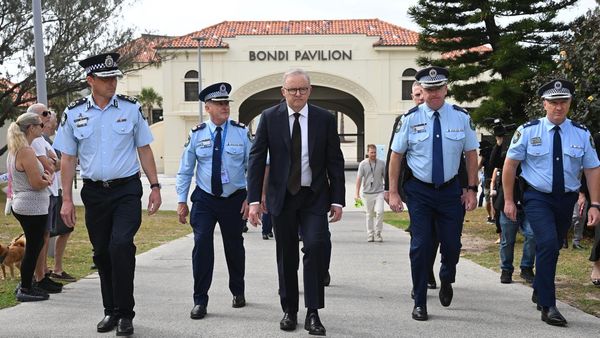
Few candidates in hyper-marginal seats arrive with the profile or sense of expectation that accompany Rebecca White.
Labor’s contender for the sprawling Tasmanian electorate of Lyons, White is a political veteran at just 42, having led the ALP in state parliament for more than six years until March last year, when she resigned following a third straight election loss.
It reads like an inglorious CV, but the blame for Labor’s decade-long losing streak in Tasmania has been broadly shared. The consensus view is that White emerged relatively unscathed.
It meant that when Anthony Albanese confirmed in November that she would be the federal candidate, it transformed the race for a seat that was central to Peter Dutton’s path to the prime ministership. White is a proven vote winner, having topped the poll in the multi-member state seat of Lyons at the past three elections, including being backed by voters who otherwise did not support Labor. Announcing her candidacy, Albanese described her as a cabinet minister in waiting.
None of which assures her of victory. The retiring backbench Labor MP, Brian Mitchell, survived the 2022 election on a margin of just 0.9%. His Liberal opponent, the industry leader and former local councillor Susie Bower, is running for a second time and has been campaigning for the best part of three years.
Four of Tasmania’s five lower house seats could be in play at this election. Two are held by Labor and two by the Liberals, with the Hobart seat of Clark in the hands of the independent Andrew Wilkie. Betting markets favour no seats changing hands, but only Clark is beyond reach for challengers.
Lyons is a rare electorate without a major geographic centre. It stretches across roughly half of the island state, taking in Hobart’s northern outskirts, the rural centre up to to the edge of Launceston, and nearly the entire east coast.
According to the psephologist Kevin Bonham, its demographics – older, less formally educated and less wealthy than average – fall in the outer suburban and regional seats that Dutton is targeting and could appeal to. “There is an argument that in a reasonably close normal election, with a normal candidate, that Labor loses,” Bonham says.
But he says White’s candidacy changed that equation and, to some extent, the election is a test of her local star power.
White says that after nearly 15 years in state parliament she was drawn to the challenge of a tight contest – “I’m a competitive person” – and, having fought five campaigns within the same boundaries, she knows the electorate better than most. She says healthcare has been the biggest issue raised with her during the campaign – a consistent Labor theme – followed by cost-of-living concerns.
“But the other one that’s struck me across the electorate is how unlikable Peter Dutton is,” she says. “I’ve had people tell me they haven’t voted for me at a state election in the past, but they will vote for me at this federal election because they don’t want Peter Dutton to be the prime minister. The older demographic have been very clear in their views about that, especially men.”
Bower has had a more troubled campaign. In an awkward interview, she told the ABC she “didn’t know” why she was running for a second time for a party that, when in power, had managed an economy in which most growth had flowed to the top 10% of income earners.
As the head of the Bell Bay Advanced Manufacturing Zone, Bower has also had to manage differences with Dutton on clean energy. She has supported renewable energy projects and a hydrogen hub proposed for Bell Bay in the state’s north, while the Liberal leader has promised to scrap production tax credits to encourage hydrogen, arguing “it is not going to work”.
But Bower says rising living costs and a belief that Labor has not done enough to address them remains the biggest issue for voters. “Cost-of-living has really hit people in Lyons hard,” she says. “It’s what I’m hearing on the doors.”
She says the size of the electorate – about 33,000 sq km – and people’s reliance on cars makes the Coalition’s promise to cut fuel excise by 25c a litre for one year an attractive idea. “That’s an average saving of $14 a tank,” she says. “People in Lyons see this as real, immediate assistance.”
A ‘narrow path’ to success
Until recently, few expected much interest to be paid to Franklin, which includes Hobart’s outer southern suburbs, the Huon Valley and the eastern shore of the Derwent River. It has been solidly Labor since 1993 and held by cabinet member Julie Collins since 2007. But an independent campaign has gained more traction than anyone expected – though just how much is difficult to assess.
The candidate is Peter George, a 73-year-old former ABC correspondent turned anti-salmon farm activist. Announced in January, his campaign was the first backed by the fundraising body Climate 200 to target a seat held by a federal Labor minister.
It was given a sudden impetus soon afterwards when more than a million salmon died in a bacterium outbreak at south-east Tasmanian fish farms, and fatty chunks of fish began washing up on beaches in parts of the electorate.
In the weeks since, George has run a highly visible and clearly well-funded campaign including broadcast advertising. He has declared $30,000 in Climate 200 backing and has been endorsed by Wilkie.
Could he win? Expert observers mostly believe it’s only an outside chance. But they also say few predicted the wave of teal success in long-held Liberal seats three years ago, and independent campaigns can sometimes catch fire quickly.
George says he sees a “narrow path” to success. It relies on Collins’s primary vote staying well below 40% (it was 36.7% in 2022) and a significant backlash on environmental issues linked to local salmon farms.
His path appeared to open up a little after the Greens’ candidate, Owen Fitzgerald, discovered he was ineligible. The minor party received 17% of the primary vote three years ago, and its botched campaign means George has less competition for the environmentally focused vote. But it narrowed again when the Liberal party directed its preferences to Labor ahead of him.
George says he has been amazed to have 500 people volunteering for his campaign and to have received enough funding (he won’t say how much) to support three full-time staff. And he was buoyed by Wilkie’s assessment that he could win.
In recent weeks he has looked to broaden his campaign, with statements on housing, education and climate change. But he is most identifiable for his position on salmon. He told a “vote salmon out” rally outside Tasmanian parliament on Sunday that he would keep “fighting for the waterways of Franklin”.
George acknowledges the issue could be a double-edged sword. “I suspect that people who are antagonistic [to his position on salmon farms] remain antagonistic,” he says. “On the other hand, there are so many people who have only stumbled across salmon as an issue because of what’s happened in the past few months, and that’s probably helped with name recognition.”
Managing the salmon disease outbreak is largely a state responsibility, but Collins has been involved in the debate as the federal minister responsible for agriculture, fisheries and forestry, and is a vocal industry supporter. She welcomed the foreign affairs minister, Penny Wong, to the electorate last week to launch her campaign.
In prepared comments to Guardian Austrlaia, Collins does not mention George or salmon. She says health is the biggest issue that people speak with her about, and emphasises Labor’s positions on urgent care clinics, the cost of living and housing. She says she wants to use her ministerial role to “continue delivering for our Tasmanian farmers”.
“I have never taken the support of the people of Franklin for granted. That’s why I’ve spent my time as their elected representative fighting for our fair share of funding,” she says.
George’s first challenge is to pull ahead of the Liberal candidate, Josh Garvin, a law graduate who has run a comparatively low-key campaign. The Liberals received nearly 27% of the primary vote in 2022.
Bonham says while it is not guaranteed, George has a “real chance” of making the final two-candidate count. “I think it is difficult to see that he can get enough to win, but it is a seat to keep an eye on.”
Eyes on Bass and Braddon
Bass, taking in Launceston and towns in the north-east, is held by Bridget Archer, who has built a reputation as an independent thinker within the Coalition, but has been relatively quiet lately. It used to be the archetypal swing seat, changing hands at every election, and Archer holds it with a margin of only 1.5%.
Until Labor’s recent resurgence in polls, there had been a widely held assumption that Archer’s strong personal support would keep her in safely after she secured an against-trend two-party swing towards her three years ago. But Labor says it believes it is winnable for its candidate, teacher Jess Teesdale.
The once-marginal Braddon, in the north-west, should be safer Liberal territory, with about an 8% margin. The seat is without an incumbent after the sitting MP, Gavin Pearce, retired. The replacement candidate is Mal Hingston, a defence contractor. Labor is running a sitting senator, Anne Urquhart.
Albanese, surfing a wave of approving polls, is reportedly confident of Labor’s chances, and a weekend YouGov poll with a small sample size claimed the ALP was ahead.
Bonham is less convinced. “If it’s a blowout election and Labor does really well it might just happen,” he says. “But it is just such a big margin.”







